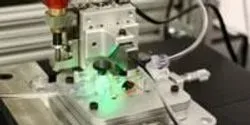Life Science

He calls himself the bug hunter, but the target of his work consists of viruses that can only be found and identified with special methods and instruments. Benjamin Hause, an assistant research professor at the Kansas State Veterinary Diagnostic Laboratory at Kansas State University, recently published an article about one of his discoveries, porcine enterovirus G, which is an important find in the United States.

Salk researchers compared a dozen stem cell lines and discovered a newer method beats out the more established protocol when it comes to creating cells that most resemble those in a human embryo.

Merck Millipore, the Life Science division of Merck, today (June 17) launched Simplicon™ RNA Reprogramming Technology, which uses synthetic self-replicating RNA to create large numbers of human induced pluripotent stem cells (iPSCs) using a single transfection step. This efficient reprogramming of somatic cells is accomplished without viral intermediates or host genome integration, offering a more defined and safer system for iPSC generation.

Problem: Molecular biology relies on the ability to precisely target and amplify nucleic acids, and next-generation sequencing (NGS) platforms and cloning reactions benefit from precise size selection and analytical characterization of samples. For decades, researchers have used electrophoresis with agarose gels for both size selection and fragment-length distribution assessment of DNA samples for downstream assays.
















